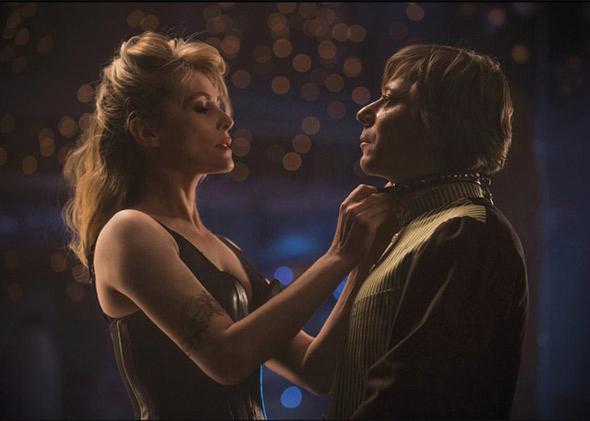Before you even start watching Roman Polanski’s Venus in Fur, an adaptation of David Ives’ Tony-nominated 2010 play inspired by the 1870 novel by Austrian author and kink pioneer Leopold von Sacher-Masoch, there are a lot of layers to peel back. There’s the awareness that Polanski—by choosing to adapt this story of an erotic S&M standoff between a theater director and an auditioning actress—is exploring, perhaps as directly as he ever has on film, his own history with women. There’s the knowledge that that history includes a guilty plea to unlawful sex with a minor, and three decades spent abroad evading sentencing for that crime. There’s the fact that Polanski has cast his wife of 25 years, Emmanuelle Seigner, in the role of the actress who would be Venus, and Mathieu Amalric—whose small stature, elfin face, and wide-set eyes unmistakably recall the filmmaker’s youthful physiognomy—in the role of the director who at once scorns, desires, and fears her.
All of that may be enough to turn you off Venus in Fur (if you haven’t already decided to boycott all of Polanski’s work on principle, in which case nothing I write here will make a difference). But before you conclude that this playfully self-referential adaptation must be little more than a misogynistic act of retroactive self-justification, give Venus in Fur a chance. If anything, the film offers a thoughtful critique of misogyny, not to mention a surprisingly nuanced exploration of the complex theater of contemporary gender relations. But above all else, Venus in Fur is a sharp, sexy comedy (adapted by Ives and Polanski from a translation by Abel Gerschenfeld) performed by two superb and superbly in-tune actors, and directed with a sure hand by a filmmaker who’s clearly not cowed by the challenge of blowing up a two-person chamber piece for the screen.
From the moment an opening tracking shot takes us down a Paris boulevard at twilight and through the door of a decrepit theater whose sign reads simply “T EATRE,” it’s evident we’re entering a performance space with its own rules. For the next hour and a half, we’re soon made to understand, the line between theater and film—like those between reality and fantasy, dominance and submission, male and female—will be less clearly drawn, and more permeable, than we’d thought. Polanski (whose last movie, Carnage, was a four-character, one-set stage adaptation that never managed to transcend its own dramatic airlessness) gets around the problem of how to film a play by foregrounding it as a problem. His camera (wielded by longtime DP Pawel Edelman) tirelessly prowls the confines of the empty theater, defining the characters’ changing power relations with subtle shifts of angle or frame, using space in a way a stage production couldn’t while never letting us forget the theatrical artifice of the setting.
The woman entering that shabby theater as the film begins (accompanied by Alexandre Desplat’s witty carnivalesque score) is Vanda (Seigner), a blowsy actress who’s late for the audition, soaking wet from rain, and not even marked down on the director’s list of scheduled candidates. But she half-guilts, half-cajoles the playwright and first-time director, Thomas (Amalric), into hearing her read for the lead role of the icy dominatrix, who, coincidentally, shares her first name. To feed Vanda her lines, Thomas, though visibly annoyed by this gum-snapping philistine, wearily agrees to assume the part of Severin, the love-struck latent masochist who will eventually take on the role of her subjugated sex slave. As the audition progresses, Thomas’ scorn turns to shock: Vanda not only seems to know the entire script by heart, but the instant she begins performing it, she transforms from a slang-spewing modern-day woman into the cool, elegant aristocrat of Sacher-Masoch’s novel. (She’s also brought along a pair of tatty costumes—a ruffled thrift-store gown for her, a smoking jacket for him—to help aid in the transformation.) Vanda—the “real” one, that is—is also prone to breaking character at any moment to remark, often derisively, on the unacknowledged sexism of the play and, by implication, its author: “He’s a perv and she’s an object, just like every woman in 18-whatever.”
Over the course of the film, Vanda and Thomas—or are they the other Vanda and Severin?—will slip in and out of character, exchange roles (and relative power positions) over and over again, and enter into the strange intimacy of two people engaged in a long-form game of make-believe. I won’t reveal any more of the wicked reversals and stratagems involved in their psychosexual game of one-upmanship, because it’s those moments that make for the film’s small surprises. In a general way, we can see where the story is headed (put it this way: things don’t get less perverse and violent as we go along), but thanks to the actors’ zesty performances and evident delight in the material, every micro-shift in their dynamic provides a fresh burst of pleasure.
The 47-year-old Seigner, who was savaged by many critics back when she appeared as an insatiable femme fatale in her husband’s campy 1992 thriller Bitter Moon, has grown into a vibrantly self-confident comedienne. Her earthy yet gimlet-eyed Vanda owes something to the secretly whip-smart ditzes of classic Hollywood, like Judy Holliday in Born Yesterday. And Mathieu Amalric is one of those actors who, like Paul Giamatti or Philip Seymour Hoffman, never turn in an uninteresting performance. If his piercing, slightly bug-eyed gaze shows up in a movie, you know at least one good thing is going to be happening onscreen (usually more, since he tends to select his projects with care.) Here Amalric gets to pull out all the stops, playing a character who’s by turns a persecuted artist, a selfish hypocrite, a victim of his own depraved appetites, and an obliviously sexist salaud—all roles Venus in Fur’s infamous 80-year-old director has either been assigned or taken upon himself over the course of a five-decade career. Who better to adapt a play about theater as an infinite succession of masks?
